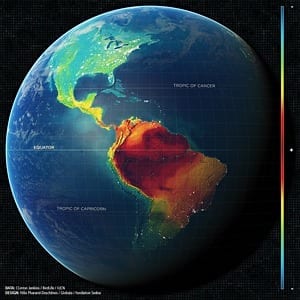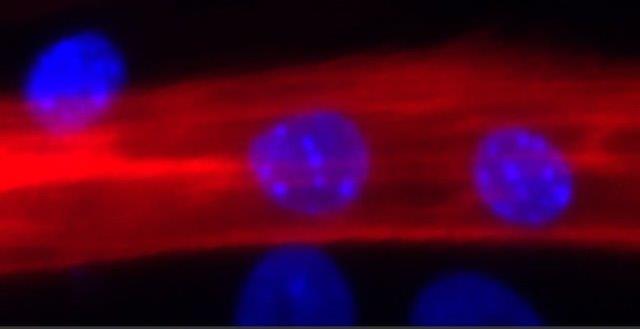
Genetic Diversity of the species significantly increased providing fresh hope for the future survival of this near-extinct species
Black-footed ferrets, a critically endangered species native to North America, have renewed hope for future survival thanks to successful efforts by a coalition of conservationists, including scientists at Lincoln Park Zoo, to reproduce genetically important offspring using frozen semen from a ferret who has been dead for approximately 20 years. The sire, “Scarface,” as he is affectionately called by the team, was one of the last 18 black-footed ferrets to exist in the world in the 1980s. Eight kits, including offspring of Scarface, were born recently, significantly increasing the gene diversity of this endangered population that a dedicated team is working to recover in the wild.
Their work published Aug. 13 in the journal Animal Conservation “Recovery of Gene Diversity Using Long-Term Cryopreserved Spermatozoa and Artificial Insemination in the Endangered Black-Footed Ferret.”
Partners working to save black-footed ferrets from extinction, and recover a healthy population back to the wild include Lincoln Park Zoo, The Smithsonian Conservation Biology Institute (SCBI), U.S. Fish and Wildlife Service, Louisville Zoological Garden, Cheyenne Mountain Zoo, Phoenix Zoo and Toronto Zoo.
“Our study is the first to provide empirical evidence that artificial insemination with long-stored spermatozoa is not only possible but also beneficial to the genetic diversity of an endangered species,” said David Wildt, lead author, senior scientist and head of the Center for Species Survival at SCBI. “What we’ve done here with the black-footed ferret is an excellent example of how sperm preservation can benefit species recovery programs.”
The U.S. Fish and Wildlife Service developed and oversee the Black-Footed Ferret Recovery Program. The Association of Zoos and Aquariums’ Species Survival Plan manages the black-footed ferret breeding program at ex situ facilities, the breeding population in which is comprised of approximately 300 animals.
“The entire species survival depends on successful captive management to ensure healthy genetics over the next 100 years and to produce individuals for the reintroduction program,” explained Black-Footed Ferret Reproduction Advisor Rachel Santymire, PhD, director of the Davee Center for Endocrinology and Epidemiology at Lincoln Park Zoo. “To balance out these demands on the breeding program, we have to ensure that each individual ferret passes its genes on to the next generation.”
Over the past several years, the team has been developing assisted reproductive technology like artificial insemination and semen cryopreservation. For this study, all of the males were managed either at SCBI or at the USFWS National Black-Footed Ferret Conservation Center. Scientists collected semen samples from adult black-footed ferrets that ranged in age from one to six years old. All females were managed at SCBI.
Initially, scientists used fresh semen to artificially inseminate females who failed to naturally mate with males, resulting in 135 kits. With just a few founders to rebuild an entire species, early managers of the black-footed ferret recovery program knew that genetic diversity would be lost. Loss of genetic variation can lead to increased sperm malformation and lower success of pregnancy over time. Researchers, led by Santymire, routinely collected and preserved black-footed ferret semen for later use as part of standard operating procedures.
SCBI developed a successful laparoscopic artificial insemination technique for black-footed ferrets. Females are induced ovulators, which mean that mating itself causes the ovary to release its eggs. SCBI researchers developed a hormone treatment that artificially causes ovulation to occur. Scientists then deposited the male’s fresh or frozen-thawed sperm directly into the female’s uterus. Animal care staff closely monitored potentially pregnant females by taking weight measurements and remote monitoring of the nest boxes via closed-circuit cameras.
During the 2008 breeding season, SCBI scientists used semen samples from four male black-footed ferrets donors that had been frozen for 10 years. Black-footed ferret Population Advisor Colleen Lynch of Riverbanks Zoo and Garden conducted population genetic analysis to select pairings of deceased sperm donors with living females based on several genetic metrics including mean kinship of the parents and inbreeding coefficients of potential offspring to maximize the genetic benefit of successful pairings. In the years that followed, subsequent AIs incorporated semen that had been cryopreserved up to 20 years, also resulting in successful pregnancies.
Read more: Critically endangered species successfully reproduced using frozen sperm
The Latest on: Conservation Biology
[google_news title=”” keyword=”Conservation Biology” num_posts=”10″ blurb_length=”0″ show_thumb=”left”]
via Google News
The Latest on: Conservation Biology
- Better reservoir management could aid food security and fisheries conservation in USon April 29, 2024 at 12:41 pm
After nearly a century of people building dams on most of the world's major rivers, artificial reservoirs now represent an immense freshwater footprint across the landscape. Yet, these reservoirs are ...
- Smithsonian's National Zoo & Conservation Biology Instituteon April 22, 2024 at 4:59 pm
More than 1,800 animals reside at the Smithsonian's 163-acre National Zoo & Conservation Biology Institute, from Asian elephants to cheetahs to sea lions. Look up every now and then as you stroll ...
- Conservation Biologyon April 16, 2024 at 1:20 pm
You are now leaving the Cambridge University Press website. Your eBook purchase and download will be completed by our partner www.ebooks.com. Please see the ...
- Conservation Biologyon November 22, 2023 at 4:51 am
Conservation biology is growing rapidly and ever increasing in importance in response to the biodiversity crisis — perhaps the most critical environmental issue of our time. Conservation biologists ...
- Wildlife and Fisheries Biology and Managementon November 12, 2023 at 1:39 pm
As a wildlife and fisheries biology and management student, you will receive a solid background in the basic sciences, zoology, conservation biology and ecology. You will also be able to choose a ...
- Bachelor of Science in Conservation Biologyon September 21, 2023 at 5:38 pm
Conservation biology is the application of science to conserve the earth's imperiled species and ecosystems. The field is growing rapidly and ever increasing in importance in response to the ...
- Wildlife Ecology and Conservation Majoron September 7, 2023 at 9:53 am
ecology or conservation biology. We are the only undergraduate program in our area where students meet the educational requirements to be certified as a wildlife biologist by the Wildlife Society at ...
- Visiting Assistant Teaching Professor of Biology (Conservation Biology/Ecology)on July 30, 2023 at 10:04 am
We seek an individual with expertise in organismal biology, ecology, and biostatistics who can teach an upper-level conservation biology course and a biostatistics course. The successful applicant ...
- Conservation Biology Informaticson July 19, 2023 at 1:35 pm
We work at the crossroads of ecology, geography, mathematics and computation. We develop and apply methods and software for conservation and land use planning. We study how decisions are dependent on ...
- Ecology, Evolution and Organismal Biology Optionon August 8, 2022 at 5:02 pm
The EEOB Option is suited for students interested in professional or academic careers in conservation biology, veterinary medicine, environmental biotechnology, or graduate studies in ecology or ...
via Bing News










